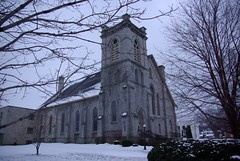
Imagine a parallel Universe where splintered Protestant churches - Methodist, Presbyterian, Congregational - magically united in 1925, leading to yoked trajectories, a serious reshuffling and unusual architectural consequence.
Welcome to Canada. The moral of the story? Perhaps that ideas matter, for it's been nearly a century, and dissolving doctrinal differences in favor of unity has not solved Mainline Protestant problems, but that's another post. Architecturally, the results were so interesting that we had to call this blog "North American Churches" lest we miss out. You could also say Canada is where this all began. The first N.A.C. discussion took place a year ago on kirchenlieder, where Lance - a fellow contributor - and I discussed the nature of the Sunday School movement and the Akron plan. Yes, it's true, we lead wild, dangerous lives.
I was in Owen Sound, Ontario at the time (my wife's hometown), and stumbled into just such a building. As you'll see in the comments, the hospitable pastor of that church kindly chimed in.
This year, back in Owen Sound, I was able to supplement those church pics with many more. The photo set will be enhanced over the years. In the meantime, Salvation Corner is of particular interest (find the four signs to match the four corner churches). While the interior of St. George's Anglican is stunning, I missed it this year, but instead, by following rule #1, got into Division Street United just before a wedding. A wonderful "Chalcedonian" window scheme is explained here. Humanity of Christ on one side, Divinity on the other, and the congregation lives the mystery "in Christ," in between. Good architecture meets good theology.
